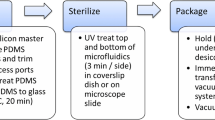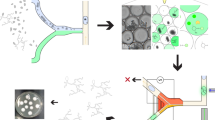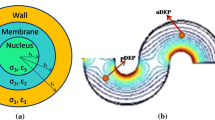Abstract
We present an integrated microfluidic system for performing isolation and concentration of Phytophthora ramorum pathogens using a chip whose working principle is based on inertial lateral migration in curving flows. The chip was fabricated from multiple layers of thermoplastic polymers and features an embedded spiral separation channel along with peristaltic microvalves for fluidic operation and process control. A pumping system paired with a fully programmable pressure manifold is used to boost concentration levels by recirculating the sample liquid multiple times through the separation chip, making it possible to reduce sample volumes from 10 to 1 mL or less. The system was calibrated using fluorescent polymer particles with a nominal diameter of 30 µm which is comparable to that of P. ramorum sporangia. The separation process has been shown to be highly effective and more than 99% of the beads can be recovered in the concentrated batch. Experiments conducted with P. ramorum sporangia have shown that a 5.3-fold increase in pathogen content with 95% recovery can be achieved using three subsequent concentration cycles. The utility of the method has been validated by processing a sample derived from infested Rhododendron leaves where a 6.1-fold increase in the concentration of P. ramorum has been obtained after four concentration cycles. Although specifically designed and demonstrated for sporangia of P. ramorum, the method and related design rules can easily be extended to other microbial organisms, effectively supporting bioanalytical applications where efficient, high-throughput separation of target species is of primary concern.






Similar content being viewed by others
References
Berger SA, Talbot L, Yao L-S (1983) Flow in curved pipes. Annu Rev Fluid Mech 15:461–512
Bhagat AAS, Kuntaegowdanahalli SS, Papautsky I (2008) Continuous particle separation in spiral microchannels using dean flows and differential migration. Lab Chip 8:1906–1914
Bilodeau GJ (2011) Quantitative polymerase chain reaction for the detection of organisms in soil. CAB Rev Perspect Agric Vet Sci Nutr Nat Resour 6:1–14
Bilodeau GJ, Lévesque CA, de Cock AWAM, Duchaine C, Brière S, Uribe P, Martin FN, Hamelin RC (2007) Molecular detection of Phytophthora ramorum by real-time polymerase chain reaction using TaqMan, SYBR Green, and molecular beacons. Phytopathology 97:632–642
Bilodeau GJ, Koike ST, Uribe P, Martin FN (2012) Development of an assay for rapid detection and quantification of Verticilium dahliae in Soil. Phytopathology 102:331–343
Bilodeau GJ, Martin FN, Coffey MD, Blomquist CL (2014) Development of a multiplex assay for genus- and species-specific detection of Phytophthora based on differences in mitochondrial gene order. Phytopathology 104:733–748
Clime L, Hoa XD, Corneau N, Morton KJ, Luebbert C, Mounier M, Brassard D, Geissler M, Bidawid S, Farber J, Veres T (2015a) Microfluidic filtration and extraction of pathogens from food samples by hydrodynamic focusing and inertial lateral migration. Biomed Microdevices 17:17
Clime L, Morton KJ, Hoa XD, Veres T (2015b) Twin tubular pinch effect in curving confined flows. Sci Rep 5:9765
Dean WR (1927) XVI. Note on the motion of fluid in a curved pipe. Philos Mag Ser 7(4):208–223
Di Carlo D, Irimia D, Tompkins RG, Toner M (2007) Continuous inertial focusing, ordering, and separation of particles in microchannels. Proc Natl Acad Sci USA 104:18892–18897
Didar TF, Li K, Tabrizian M, Veres T (2013) High throughput multilayer microfluidic particle separation platform using embedded thermoplastic-based micropumping. Lab Chip 13:2615–2622
Ganz KR, Clime L, Farber JM, Corneau N, Veres T, Dixon BR (2015) Enhancing the detection of Giardia duodenalis cysts in foods by inertial microfluidic separation. Appl Environ Microbiol 81:3925–3933
Geissler M, Li K, Zhang X, Clime L, Robideau GP, Bilodeau GJ, Veres T (2014) Integrated air stream micromixer for performing bioanalytical assays on a plastic chip. Lab Chip 14:3750–3761
Gossett DR, Di Carlo D (2009) Particle focusing mechanisms in curving confined flows. Anal Chem 81:8459–8465
Hur SC, Tse HTK, Di Carlo D (2010) Sheathless inertial cell ordering for extreme throughput flow cytometry. Lab Chip 10:274–280
Hur SC, Choi S-E, Kwon S, Di Carlo D (2011) Inertial focusing of non-spherical microparticles. Appl Phys Lett 99:044101
Inglis DW, Herman N, Vesey G (2010) Highly accurate deterministic lateral displacement device and its application to purification of fungal spores. Biomicrofluidics 4:024109
Julich S, Riedel M, Kielpinski M, Urban M, Kretschmer R, Wagner S, Fritzsche W, Henkel T, Möller R, Werres S (2011) Development of a lab-on-a-chip device for diagnosis of plant pathogens. Biosens Bioelectron 26:4070–4075
Kotz KT, Petrofsky AC, Haghgooie R, Granier R, Toner M, Tomkins RG (2013) Inertial focusing cytometer with integrated optics for particle characterization. Technology 1:27–36
Kuntaegowdanahalli SS, Bhagat AAS, Papautsky I (2009) Continuous multi-particle separation using deterministic focusing in spiral microchannels. In: Transducers 2009–2009 international solid-state sensors, actuators and microsystems conference, pp 2139–2142
Mach AJ, Di Carlo D (2010) Continuous scalable blood filtration device using inertial microfluidics. Biotechnol Bioeng 107:302–311
Martel JM, Toner M (2014) Inertial focusing in microfluidics. Annu Rev Biomed Eng 16:371–396
Martin FN, Abad ZG, Balci Y, Ivors K (2012) Identification and detection of Phytophthora: reviewing our progress, identifying our needs. Plant Dis 96:1080–1103
Nivedita N, Papautsky I (2013) Continuous separation of blood cells in spiral microfluidic devices. Biomicrofluidics 7:054101
Rafeie M, Zhang J, Asadnia M, Li W, Warkiani ME (2016) Multiplexing slanted spiral microchannels for ultra-fast blood plasma separation. Lab Chip 16:2791–2802
Rizzo DM, Garbelotto M, Hansen EM (2005) Phytophthora ramorum: integrative research and management of an emerging pathogen in California and Oregon forests. Annu Rev Phytopathol 43:309–335
Roy E, Geissler M, Galas J-C, Veres T (2011) Prototyping of microfluidic systems using a commercial thermoplastic elastomer. Microfluid Nanofluid 11:235–244
Saffman PG (1965) The lift on a small sphere in a slow shear flow. J Fluid Mech 22:385–400
Saffman PG (1968) The lift on a small sphere in a slow shear flow—Corrigendum. J Fluid Mech 31:624
Schonberg JA, Hinch EJ (1989) Inertial migration of a sphere in Poiseuille flow. J Fluid Mech 203:517–524
Segré G, Silberberg A (1961) Radial particle displacements in Poiseuille flow of suspensions. Nature 189:209–210
Tomlinson JA, Boonham N, Hughes KJD, Griffin RL, Barker I (2005) On-site DNA extraction and real-time PCR for detection of Phytophthora ramorum in the field. Appl Environ Microbiol 71:6702–6710
Werres S, Marwitz R, Man in’t Veld WA, de Cock AWAM, Bonants PJM, de Weerdt M, Themann K, Ilieva E, Baayen RP (2001) Phytophthora ramorum sp. nov., a new pathogen on Rhododendron and Viburnum. Mycol Res 105:1155–1165
Acknowledgements
This work was supported in part by Canada’s Genomics Research and Development Initiative (GRDI) under the program “Protection of Canadian Biodiversity and Trade from the Impacts of Global Change through Improved Ability to Monitor Invasive Alien and Quarantine Species.” We thank our colleagues Maxence Mounier (NRC), Alex Boutin (NRC), Hélène Roberge (NRC), Hadil Sayed (CFIA), Ian King (CFIA), Émilie Tremblay (CFIA) and Debbie Shearlaw (CFIA) for technical assistance and useful discussion.
Author information
Authors and Affiliations
Corresponding author
Rights and permissions
About this article
Cite this article
Clime, L., Li, K., Geissler, M. et al. Separation and concentration of Phytophthora ramorum sporangia by inertial focusing in curving microfluidic flows. Microfluid Nanofluid 21, 5 (2017). https://doi.org/10.1007/s10404-016-1844-9
Received:
Accepted:
Published:
DOI: https://doi.org/10.1007/s10404-016-1844-9




